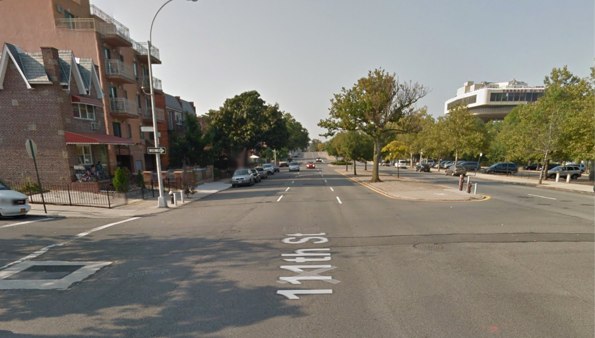
Residents and community groups in Corona are working to tame traffic on an extra-wide street that separates their neighborhood from the largest park in Queens. They're backed by a council member who, in addition to putting aside funds for the project, is asking the city to bring bike lanes and traffic calming to the rest of her district.
Flushing Meadows-Corona Park is surrounded almost entirely by highways, making access from surrounding neighborhoods difficult. One section of the park, home to the New York Hall of Science, crosses the Grand Central Parkway and extends to 111th Street. Corona residents must cross the street to get to the park. Even though it's not an arterial road, 111th is designed like one, with up to three lanes in each direction and a center median.
"It's a legacy of the planning for the World's Fair," said Jose Serrano, a community organizer at the Queens Museum, which is located within the park. "It's a legacy of a fair that was meant to be a regional destination, and not necessarily about planning for connectivity between the park and the local community."
Earlier this year, the Queens Museum began working with Immigrant Movement International, Make the Road New York, and Transportation Alternatives to hear what local residents have to say about street safety. In July, the groups hosted a Vision Zero workshop to gather feedback.
“What stood out overwhelmingly was that neighbors wanted to see big-time change on 111th Street, both for pedestrians and for cyclists,” said Celia Castellan of Transportation Alternatives. “It connects everyone to Flushing Meadows-Corona Park.”
"We have a beautiful park here in Queens," said Cristina Camacho, a member of Make the Road. “The people who live along 111th Street, they were having a lot of concerns about their children.”
In September, the groups organized a daffodil planting on the 111th Street median. At the event, they asked for more feedback on how residents thought the street should be designed. There were lots of ideas, from more stop lights and crosswalks to a protected bike lane. Some residents suggested converting the northbound lanes to a bike and pedestrian zone that could also have space for vendors, Serrano said.
Their ideas could become a reality. In fiscal year 2014, Council Member Julissa Ferreras allocated $2.7 million in discretionary capital funds to a redesign of 111th Street. On Thursday, she is meeting with DOT to get an update on how the money could be spent.
That's not all: At the Vision Zero workshop, residents also expressed an interest in more bike lanes and traffic calming. In September, Ferreras sent a letter to DOT asking for new bike routes, bike parking, pedestrian improvements, and slow zones [PDF].
"I would like to know that bike lanes are going to get to the park," Ferrerras told Transportation Commissioner Polly Trottenberg last week. "We just want bike lanes so my residents can get to and from the train safely and across from one part of the district to the other."
Ferreras is no stranger to livable streets. She was an early supporter of the Corona Plaza, and has long backed street safety initiatives in her district. The issue isn't new to residents, either. Dahlia Goldenberg, an organizer at Make the Road, said much of the interest in street safety and park access has grown out of advocacy residents have done on Corona Plaza, programs to get more women bicycling, and against development in Flushing Meadows-Corona Park.
"Latino communities, low-income communities have not typically been the center of the advocacy movement for safer streets, for safer cycling in New York City," Goldenberg said. "This is a really great instance of a community that isn't really at the forefront of this advocacy movement around Vision Zero and safer streets, really taking it on."
For her part, Ferreras seems determined to make sure her allocation for 111th Street is put to good use. “It's definitely something the communities want," said Ferreras aide Ivan Acosta. "It’s something that we’re going to fight for.”





